The Lilith Blog
November 14, 2019 by Chanel Dubofsky
The Controversial Centerpiece of the Other Israel Film Festival
By Chanel Dubofsky
In 2015, Israa Jaabis’s car exploded at a checkpoint. The 33 year old Palestinian suffered first and third degree burns over 60 percent of her body and was charged with attempted murder.
It wasn’t intentional, Jaabis’s sister told Lea Tsemel, the Jerusalem lawyer at the center of the documentary, “Advocate,” directed by Rachel Leah Jones and Philippe Bellaiche. The explosion was a technical glitch, not a terrorist attack. Also, she told Tsemel, there was the fact that her sister had attempted suicide multiple times in the past.
- 1 Comment
November 13, 2019 by Amy Stone
Our Reviewer’s Picks at the Other Israel Film Festival
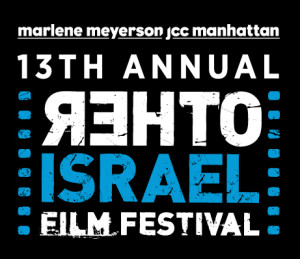
Women directors are no longer a big deal, so take note of these four women-
made films worth seeing no matter who made them. Check the OIFF website for
additional films and events.
Breaking Bread (Director Beth Hawk; JCC Sunday, Nov 17, 4:30 pm) At last, food as the bridge to understanding in a film
festival that’s hungry for hope. Dr. Nof Atamna-Ismaeel was first Muslim Arab to
win Israel’s Master Chef competition. The microbiologist from an Arab town in
northern Israel is using her food festival for social change.
Border of Pain (Director Ruth Walk; international premiere JCC Wednesday,
Nov. 20, 6:15 pm) Food and medicine, two ways
to break down walls. The sturdy, head-covered Gaza and West Bank women
determined to get permission to enter Israel for life-saving hospital care. The
Israeli doctors and volunteers who are part of an elaborate health care
bureaucracy knitting together Israel and Palestinian Authority ministries. And the
amazing Dalia Bassa, health coordinator for Israel’s civil administration. Blonde
hair, pink shirt, driving from border crossings to hospitals, her cell phone never
stops ringing.
- No Comments
November 11, 2019 by admin
Why She Needed to Create the Jews of Color Torah Academy
By Arielle Korman
In October 2018, I sat alone in the rare book room in the library at Columbia University with a dusty pink notebook that had once belonged to a 17th-century Moroccan Yeshiva student. The script was challenging to read and yet, with focus and my ever-growing knowledge of Hebrew–and access to scholars of Jewish Studies to guide me–I found myself able to engage in an encounter with his writing and watch as his thoughts and educational life emerged from the page. Education could give me the tools to ignite histories and Torah simultaneously ancient and new.
I remember a time not long ago in which I could read Hebrew, chant it, recognize words, but not understand the text before me. I remember visiting Orthodox cousins and watching them davening, a flurry of words on their tongues. In contrast, my immediate family could not speak a word of Hebrew and, for a long time, Hebrew remained a mystery language to us.
- No Comments
November 8, 2019 by Amy Stone
The New Documentary Featuring Golda Meir’s Off-the-Record Interview
At DOC NYC film festival —
“Golda” Meir – starring a long buried Israel TV interview
and how the film changed an Israeli Black Panther leader
by Amy Stone
My viewing companion came away from “Golda” visibly shaken, saying “Golda Meir was a hero. How could they show an off-the-record interview? Can’t they let her rest in peace?”
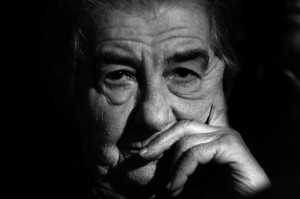
Photo Credit: Saar Yaakov GPO
The new documentary “Golda” – international premiere Nov. 10 at DOC NYC film festival– makes the conflict clear from the get go: Israel’s only woman prime minister (from 1969-74) changed the course of Middle East and global history. In America, she is known as the iconic grandmother of Israel. But in Israel she remains a controversial figure, excoriated for the loss of life in the 1973 Yom Kippur War.
What’s new is the never-before-seen footage of an off-the-record conversation with Golda, which took place following a 1978 Israel Television interview when the cameras kept rolling. Over numerous unfiltered cigarettes (Israel TV would not have shown images of her smoking), Golda Meir talked frankly. The two younger male journalists assured her the footage would not be aired.
- No Comments
November 7, 2019 by Yona Zeldis McDonough
Chutzpah: A Former Israeli Defense Intelligence Commander’s Guide to Business and Parenting
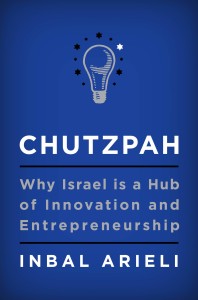
In her new book, Chutzpah: Why Israel is a Hub of Innovation and Entrepreneurship (HarperCollins), entrepreneur extraordinaire Inbal Arieli offers a penetrating analysis of how Israeli culture, especially mandatory military service, informs the dynamics of business. She talks to Lilith Fiction Editor Yona Zeldis McDonough about where she’s been and what lessons she’s learned along the way.
Yona Zeldis McDonough: How has your experience in the Israeli Defense Force Intelligence unit influenced your work in the Israeli tech sector?
Inbal Arieli: I had the privilege to be selected, at the age of 17+, to serve in the Intelligence 8200 unit, the Israeli equivalent of the N.S.A. Through the unique screening process this unit applies, I learned that what I already know is less important than what I could potentially learn. This approach, of focusing on talent potential, versus existing knowhow or experience, still influences the way I assess team members and candidates in the ventures I lead in the tech sector.
During my military service, I was part of a team of young people who came from different backgrounds, applied different approaches to problem solving and addressed challenges in various ways. This taught me that cross-pollination of ideas, and diversity, are extremely valuable for any team.
At the age of 19, I was appointed as team leader. I was the commander of a team of 15 soldiers, some older than I, definitely more experienced and knowledgeable. I then learned that leadership traits are much more critical than formal hierarchy. My team members, colleagues and commanders at 8200 are still a substantial portion of my professional network to date, more than two decades after finalizing my military service.
As a team, we faced intel challenges which seemed at first impossible to achieve. But given their importance and consequences for the security of Israel, we just had to overcome them. In 8200 I learned that there is no such thing as impossible.
All of these lessons I experienced and learned at 8200, and many more, have influenced my professional career. For me, as someone who is interested in technology, the Israeli tech sector was a natural choice, as it was for many friends from the unit. However, these lessons are applicable to any sector.
- No Comments
November 3, 2019 by Eleanor J. Bader
Toxic Tango: Site-Specific Art for Environmental Crisis
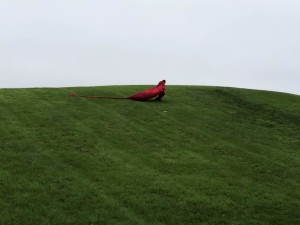
Scarlett Wardrop
When artist Julie Laffin and writer-teacher Jennifer Natalya Fink talk about environmental degradation, they focus on more than rising sea levels, polluted air, fouled waterways, and animal extinction. In fact, their site-specific art project, Toxic Tango, asks viewers to draw connections between our physical, emotional, and public domains, in essence making the personal political and vice-versa.
Performed just twice, in South Bend, Indiana, and Washington, DC, Toxic Tango aims to raise consciousness, unsettle viewers, and provoke debate about how best to promote tikkun olam, the healing of our devastated planet.
Laffin, based in Illinois, and Fink, based in Maryland, spoke to Eleanor J. Bader by phone in early October.
Eleanor J. Bader: Where did the idea for Toxic Tango originate?
Julie Laffin: I have a long history of making gowns and inserting myself into public spaces to promote a particular idea, but after I became disabled 15 or so years ago, I could no longer do this. I have environmental illness. Unfortunately, not much is known about these things. Is it a brain injury? Is it an endocrine disorder? Toxic overload? No one knows. What I do know is that these illnesses are idiosyncratic. People with them have a lot of different symptoms including respiratory difficulties and food sensitivities. Since I can’t easily go into public spaces anymore, but still want to make art that intervenes in public life, I’ve looked for surrogates, other women, who enact the performance pieces I co-create.
Jennifer Natalya Fink: Julie and I went to graduate school together at the School of the Art Institute of Chicago from 1988 to 1990. We connected again over disability – I have a daughter on the autism spectrum and, as she said, Julie has environmental illness. We started talking about doing a performance that addressed environmental contamination and found an opportunity to collaborate in the fall of 2018. I was going to &NOW, a conference at Notre Dame University. The city of South Bend, Indiana, where Notre Dame is located, is very flat, with areas of extreme wealth and areas that are poor and largely African American. LaSalle Park is in the African American neighborhood and was built on a toxic waste site. It looks like a huge mound in an otherwise flat landscape.
Julie and I devised a performance for this park. I wore a beautiful, glamorous, 100-foot-long red dress which played into the spectacle of the female body. The performance involved me running up a huge hill, then rolling down until I was bound up in the dress. At one point I inserted dirt into my stomach via a hidden pouch. As I moved up and down the mound, Julie read the government’s Super Fund Report about the site’s contamination. She was audible through my cellphone. At the end of the performance, we gave out leaflets that explained the context for what we were doing. We informed people that the Park was designated as a Super Fund site in 2013, but that both state and federal officials had known that the land was contaminated as early as 1984. Why, we asked, hadn’t it been cleaned before the park was constructed?
- No Comments
November 1, 2019 by admin
What Jews Don’t Talk About When They Talk About Jews. And Who Does the Talking.
By Diana Bletter
The same morning that the “Judaism, Israel and Diaspora” Conference was set to begin at the International Convention Center in Jerusalem on Wednesday, October 31 – with a roster of speakers about to examine diverging definitions of Judaism, world Jewry and Jewish identity – Israeli police stopped women from bringing into the Kotel, or Western Wall, Torah scrolls to pray with at Rosh Hodesh services for the start of the Jewish month of Heshvan.
The two events happened almost simultaneously, almost as if there were two sets of people replying to the same question about who owns Judaism, who gets to authorize it, and who serves as its gatekeepers. One set of people was exploring these queries in an academic forum sponsored by Haaretz newspaper, The Jewish Agency for Israel, The Hebrew University of Jerusalem and the Ruderman Family Foundation; the other set was comprised of more than two hundred women trying to claim the right to their own interpretation of Judaism, attempting to change the facts on the ground, in real time.
Nashot haKotel, or Women of the Wall, has worked since 1988 to enable women to be allowed to pray together (out loud) and read from a Torah scroll at the Kotel while the Western Wall Heritage Foundation, the Orthodox Israeli group recognized by the government as the Kotel’s guardians, prevented the women from practicing their vision of Judaism, saying that the women with the Torah scrolls were behaving in a “provocative and political” way.
- 2 Comments
October 31, 2019 by admin
So You Have a Yetzer HaRa! A Training Guide for Primitive Breeds
by Jessica Jacobs
When writing about the yetzer hara, the “evil inclination,” rabbis have grappled with the exalted algebra that if God created everything, then God must have also created this inclination. Thus, even this “evil” part of us must have some essence of the divine. Through Midrash and Mishnah (the oral tradition of Jewish law and commentaries on Jewish foundational texts), rabbis traded advice on the best techniques for dealing with the yetzer hara, which have been boiled down to this convenient training guide—because who doesn’t need a little help when attempting to housebreak this pesky propensity?
Your yetzer hara is both the seed of your physical needs and desires—those urges that drive you toward pleasure and productivity—and the MiracleGro that can get those urges sprouting like kudzu, climbing, coiling, and overtaking every other part of your life, smothering everything it covers.
But as it says in the Talmud (that training guide of all training guides), how you respond to your yetzer hara is up to you: “At first, the yetzer hara—the evil inclination—is called a ‘wayfarer’, then a ‘guest’, then finally ‘master’.” Though your yetzer hara may be cute as a puppy when young, you must assert yourself early on as pack leader. A puppy who knows it can win against its human will become a dangerous dog, an owner of its owner.
- No Comments
October 17, 2019 by admin
The One Thing More Useful Than Marching for Climate Change
By Victoria Gagliardo-Silver
I attended the Climate March in New York City two weeks ago, and I’ve been thinking about it often. People came out in droves to call for a more environmentally conscious world, and that should be celebrated. It should be exciting to see a mass mobilization for such an important issue. That’s why I am sad to say that I found myself severely disappointed.
I expected to be inspired to see so many people, particularly teenagers, turning out to protect the environment. I wanted to be moved by entire generations of people carrying signs and chanting. Instead, I was faced with the realization that most of the protestors were active contributors to climate change, telling themselves they were taking real action by marching and using metal straws. Almost all of the marchers had paper or cardboard signs drawn on with permanent marker. Some used carried single use water bottles. Many carried leather purses. But the real disappointment? Most of the protesters eat meat, eggs, and dairy.
What people––many of whom want to protect the environment––do not realize is that animal agriculture is one of the largest drains on the earth’s natural resources. It is both the second leading cause of ozone-depleting greenhouse gases and the first of deforestation, it wastes grain and water, it is killing for pleasure.
- No Comments
October 16, 2019 by Elana Rebitzer
Timekeeping on the Jewish Calendar
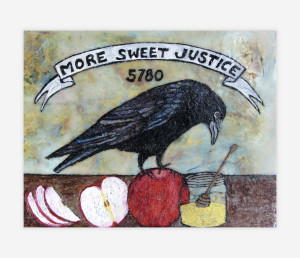
The Radical Jewish Calendar for 5780. Art by Wendy Elisheva Somerson.
As everyone who has ever frantically googled “is today a Jewish holiday” knows, the Jewish semi-lunar calendar marks time completely independently from the Gregorian solar calendar that the secular world uses, creating confusion and frustration for Jews trying to live in both worlds.
My own solution to the conflicting calendars, adding the “Hebcal” extension which gave dates and times of holidays and candle lighting to my online Google Calendar, worked well for about six days. Until the seventh, when I turned off my phone for Shabbat, and found myself in need of some sort of physical planner so that I could access my calendar even when I was not using electronics. I am using the smartwatch with the planner which I got from reading the reviews online on SpotTheWatch but decided to go full manual with the calendar.
- No Comments
 Please wait...
Please wait...